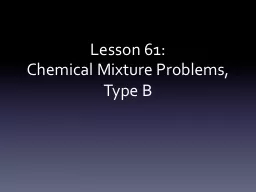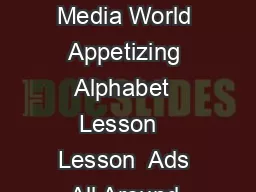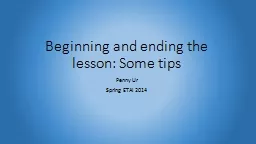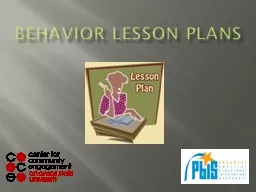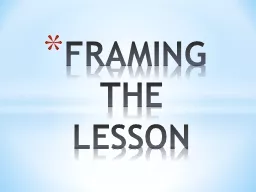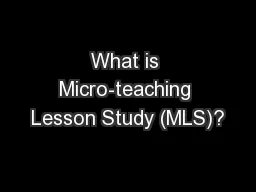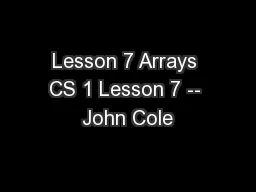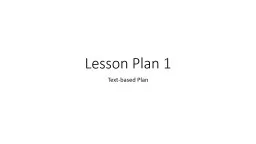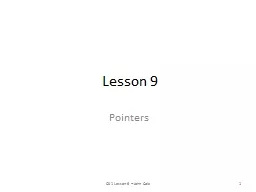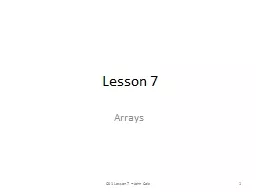PPT-Lesson 61:
Author : liane-varnes | Published Date : 2017-07-23
Chemical Mixture Problems Type B In the chemical mixture problems worked thus far we have mixed two solutions of different percentage concentrations to get a mixture
Presentation Embed Code
Download Presentation
Download Presentation The PPT/PDF document "Lesson 61:" is the property of its rightful owner. Permission is granted to download and print the materials on this website for personal, non-commercial use only, and to display it on your personal computer provided you do not modify the materials and that you retain all copyright notices contained in the materials. By downloading content from our website, you accept the terms of this agreement.
Lesson 61:: Transcript
Chemical Mixture Problems Type B In the chemical mixture problems worked thus far we have mixed two solutions of different percentage concentrations to get a mixture that has a different percentage concentration from either of the original solutions It is interesting to note that the percentage concentration of the final mixture must fall between the percentage concentrations of the two solutions used . Discuss native speaker pronunciation gonna Stress that they dont have to do it but they need to be able to understand it Use selected items from textbook exercises for student practice and to identify and clear up any confusion Strategy Presentation Penny Ur. Spring ETAI 2014. In principle…. Teachers don’t share enough. Don’t leave it too late!. A. Beginning the lesson. 1. Smile. Surprisingly important. Underlying message. A neutral expression is not a neutral message.. Acknowledgements. Portions of this presentation were adapted from work and presentations by the following:. Illinois PBIS Network training materials and . curricula. Tim Lewis, Ph.D., University of Missouri. To be able to plan lessons using the manor overview slide and . teaching cycle.. Planning a lesson & the lesson overview slide. 5 . mins. Core Lesson Structure. Learning and Teaching at The Manor Academy. identify the components of an effective. lesson frame so that we can write our frames properly in our classrooms throughout the school year.. write . a frame for one of the lessons I will. teach during the first week of school, and I will share it with one of my team members.. Lesson study, microteaching, and MLS . MLS. was developed by combining elements of . lesson study . and . microteaching. (. Fernández. , 2005).. Then, what is . Lesson study. ?. How did . Mcmahon. 1. Arrays Hold Multiple Values. Array. : variable that can store multiple values of the same type. Values are stored in adjacent memory locations. If a variable is the name of a memory location, an array is the name of a group of them.. Lesson 2- Lexical Approach. Lesson 3- Task-based . Lesson Plan 1 . Text-based Plan . Presentation Phase . Type of text . So you’re in Thunder Bay what do you do now?. *****PICTURES WILL BE INSERTED HERE . 1. Pointers in Wonderland. The name of the song is called ‘. Haddock’s Eyes’.” . “Oh, that’s the name of the song, is it?” Alice said, trying to feel interested. “No, you don’t understand,” the Knight said, looking a little vexed. “That’s what the name of the song is . 1. Arrays Hold Multiple Values. Array. : variable that can store multiple values of the same type. Values are stored in adjacent memory locations. If a variable is the name of a memory location, an array is the name of a group of them.. What are some common themes that you have noticed-that we have discussed in every unit thus far (topics that seem to be shared by all the people we have studies about so far)?. How do you think the character of people hundreds of years ago compares to the character of the modern world? What factors do you think play a role in the difference/changes?. g /g/. u. c. d. o. n. i. f. p. t. s. m. a. g. got. gas. g. dog. tag. g. g. tug. gap. fog. mug. dog. tag. pig. got. gas. gum. gut. Insert brief reinforcement activity and/or transition to next part of reading block.. -y. y. dge. g. ch. tch. -ed. c. a. i. o. e. u. nk. ng. wh. ph. th. sh. ck. Suffixes. added to the end of a word to change the word’s meaning. -y. full of or described as. cloud. y. sleep. y. s. u. n.
Download Document
Here is the link to download the presentation.
"Lesson 61:"The content belongs to its owner. You may download and print it for personal use, without modification, and keep all copyright notices. By downloading, you agree to these terms.
Related Documents

